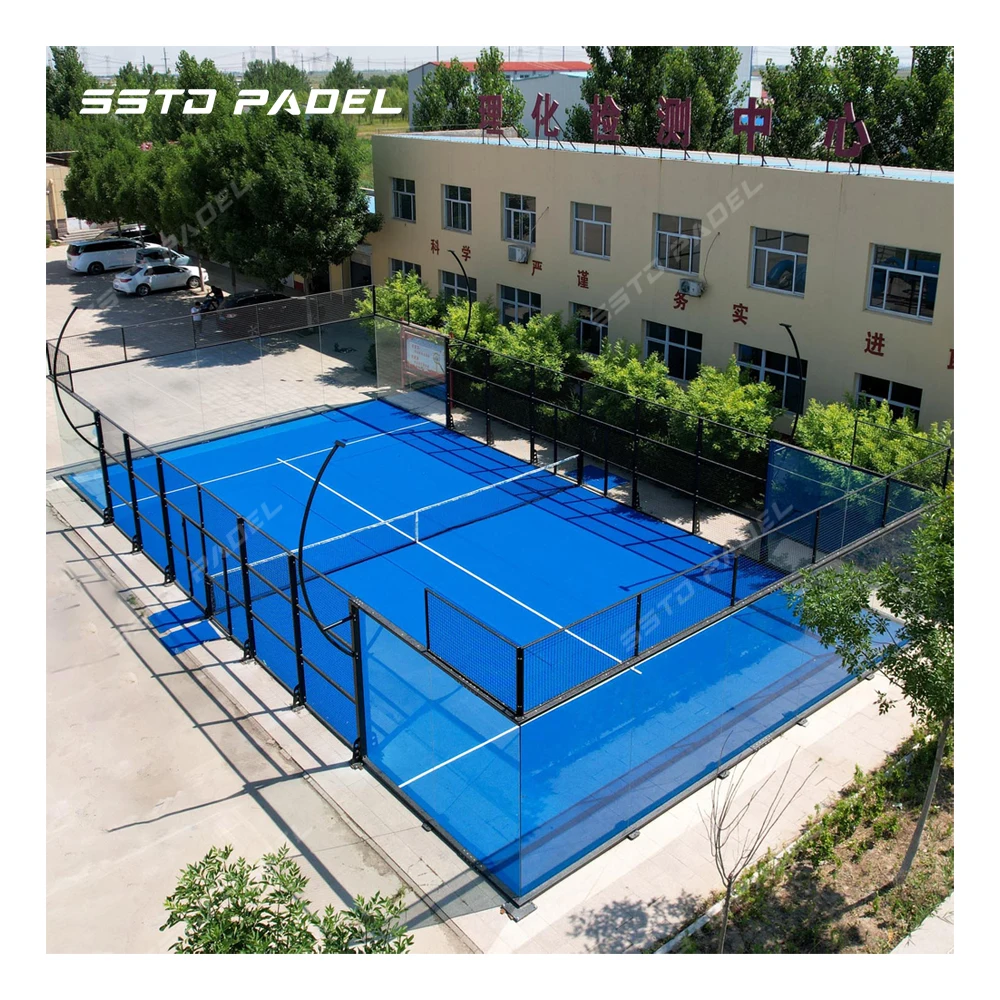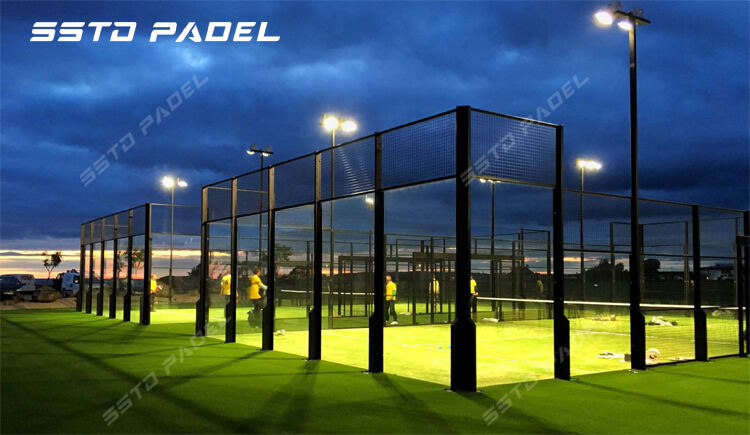The relationship between court design and athletic performance in padel tennis has become increasingly significant as the sport continues to gain global popularity. Professional players and recreational enthusiasts alike are discovering that the structural elements of a padel court directly influence gameplay dynamics, safety standards, and overall player comfort. Understanding these design factors enables facilities to optimize their courts for enhanced performance while ensuring maximum player satisfaction and injury prevention.

Modern padel tennis facilities recognize that court design extends far beyond basic structural requirements. The integration of advanced materials, precise dimensional specifications, and strategic layout considerations creates an environment where players can perform at their peak potential. These design elements work synergistically to influence ball behavior, player movement patterns, and the overall tactical approach to the game.
Surface Material Impact on Performance
Artificial Turf Technology
The selection of artificial turf significantly affects ball bounce consistency and player traction during competitive play. High-quality synthetic grass systems provide uniform surface characteristics that allow players to predict ball behavior with greater accuracy. The fiber density and backing material determine the court's response to different playing styles and weather conditions.
Advanced turf technologies incorporate specialized infill materials that enhance shock absorption and reduce joint stress during extended play sessions. These innovations contribute to improved player comfort while maintaining the authentic feel that padel tennis demands. The surface texture directly influences spin generation and ball control techniques that define successful padel strategies.
Sand Distribution Systems
Proper sand distribution across the playing surface ensures optimal ball speed and bounce characteristics throughout the entire court area. Professional-grade sand systems utilize specific grain sizes and compositions that complement the artificial turf to create ideal playing conditions. The depth and evenness of sand coverage directly impact player footing and sliding capabilities during dynamic movements.
Maintenance protocols for sand systems require regular redistribution and replenishment to maintain consistent performance standards. Players experience improved stability and confidence when the surface provides predictable traction patterns. These factors contribute to enhanced gameplay quality and reduced risk of surface-related injuries.
Wall Construction and Ball Interaction
Glass Panel Specifications
The quality and positioning of glass panels fundamentally alter the strategic elements of padel tennis gameplay. Tempered safety glass with appropriate thickness provides consistent ball rebound characteristics while ensuring player safety during intense rallies. The seamless integration between glass sections eliminates irregular bounce patterns that could disrupt game flow.
Professional installations utilize specialized mounting systems that maintain glass stability under varying environmental conditions. These systems accommodate thermal expansion while preserving the precise angles necessary for optimal ball trajectory. Players benefit from predictable wall interactions that allow for advanced tactical planning and execution.
Metal Mesh Integration
The transition zones between glass panels and metal mesh sections require careful engineering to ensure smooth ball movement across different surface types. High-grade mesh materials provide appropriate ball retention while allowing sufficient visibility for spectators and players. The mesh tension and mounting methodology directly influence how balls interact with these areas during play.
Strategic placement of mesh sections affects the overall court aesthetics while maintaining functional requirements for ball containment. The integration of these materials creates distinct playing zones that experienced players incorporate into their tactical approaches. Proper mesh installation eliminates potential safety hazards while preserving the authentic padel tennis experience.
Dimensional Accuracy and Player Movement
Court Size Standardization
Adherence to official dimensional standards ensures that players develop consistent movement patterns transferable across different facilities. Precise measurements of court length, width, and wall heights create uniform playing conditions that support skill development and competitive integrity. These specifications directly impact player positioning strategies and court coverage techniques.
Professional padel court installations utilize advanced surveying techniques to achieve millimeter-level accuracy in construction. This precision eliminates variations that could disadvantage players accustomed to standard court dimensions. Consistent sizing enables fair competition and supports the development of standardized training programs.
Entry and Exit Accessibility
Strategic positioning of court entrances affects player safety and convenience while maintaining structural integrity of the enclosure. Modern designs incorporate wider entry points that accommodate equipment transport and emergency access requirements. The entrance design must balance accessibility with the need to maintain proper ball containment during play.
Safety considerations for entry systems include automatic closing mechanisms and impact-resistant materials that protect both players and spectators. These features contribute to overall facility management efficiency while ensuring compliance with safety regulations. Proper entrance design enhances the overall user experience without compromising competitive standards.
Lighting and Visual Performance
LED Illumination Systems
Advanced LED lighting configurations provide uniform illumination that enhances ball visibility and reduces eye strain during extended play sessions. Professional-grade lighting systems eliminate shadows and glare patterns that could interfere with player performance. The color temperature and intensity levels are carefully calibrated to optimize visual acuity for both players and spectators.
Energy-efficient lighting solutions reduce operational costs while maintaining superior performance standards. These systems incorporate smart controls that adjust brightness levels based on ambient conditions and usage patterns. Consistent lighting quality across the entire court area ensures fair playing conditions regardless of the time of day or weather conditions.
Glare Reduction Technologies
Strategic placement of lighting fixtures and the integration of anti-glare technologies create optimal visual conditions for competitive play. Specialized diffusion systems distribute light evenly while minimizing direct glare that could impair player vision. These technologies are particularly important for outdoor courts where natural sunlight must be managed alongside artificial illumination.
Professional installations incorporate adjustable fixtures that can be fine-tuned to accommodate different playing conditions and tournament requirements. The elimination of visual distractions allows players to maintain focus on gameplay while reducing the risk of accidents caused by poor visibility. These improvements contribute significantly to player comfort and performance consistency.
Climate Control and Environmental Factors
Ventilation System Design
Proper air circulation within enclosed padel courts maintains comfortable playing conditions while preventing condensation buildup that could affect surface traction. Advanced ventilation systems utilize strategic air movement patterns that minimize wind interference with ball flight while ensuring adequate fresh air exchange. These systems are particularly crucial for indoor facilities where natural airflow is limited.
Temperature regulation through efficient ventilation contributes to player comfort and extends the usable hours of facility operation. Modern systems incorporate energy recovery technologies that maintain optimal conditions while minimizing operational costs. Consistent environmental conditions allow players to focus on performance without distraction from uncomfortable playing conditions.
Weather Protection Features
Covered court designs protect players from adverse weather conditions while maintaining the outdoor feel that characterizes traditional padel tennis. Roof structures must balance protection from rain and excessive sun exposure with adequate ventilation and natural lighting. These design considerations directly impact year-round facility utilization and player satisfaction.
Drainage systems integrated into court design prevent water accumulation that could create unsafe playing conditions or damage court surfaces. Proper slope gradients and drainage placement ensure rapid water removal while maintaining level playing areas. These features are essential for maintaining consistent court availability and protecting infrastructure investments.
Safety Integration and Injury Prevention
Impact Absorption Technologies
Advanced surface technologies incorporate shock-absorbing materials that reduce the impact forces transmitted to players during intense gameplay. These systems help prevent common injuries associated with repetitive movements and sudden directional changes characteristic of padel tennis. The integration of these technologies maintains authentic ball behavior while enhancing player safety.
Multi-layer construction systems distribute impact forces across larger surface areas, reducing stress concentrations that could lead to injury. Professional installations utilize materials specifically engineered for high-impact sports applications. These safety features enable players to perform at maximum intensity with reduced risk of surface-related injuries.
Emergency Access Considerations
Court design must accommodate emergency response requirements while maintaining the enclosed nature essential to padel tennis gameplay. Strategic placement of emergency exits and communication systems ensures rapid response capabilities when needed. These safety features are integrated seamlessly into the overall design aesthetic without compromising functionality.
Clear sight lines for supervision and emergency monitoring are incorporated into modern court designs through strategic placement of transparent materials and observation areas. These features support facility management responsibilities while maintaining player privacy and game integrity. Proper safety integration demonstrates professional facility management and regulatory compliance.
FAQ
What surface materials provide the best performance for padel courts
High-quality artificial turf with specialized sand infill systems delivers optimal performance by providing consistent ball bounce and reliable player traction. Professional-grade synthetic grass materials offer durability and weather resistance while maintaining the authentic playing characteristics that define competitive padel tennis. The combination of proper fiber density and appropriate sand distribution creates ideal playing conditions that support both recreational and competitive use.
How does wall height affect gameplay strategy in padel tennis
Standard wall heights of 3-4 meters create specific strategic opportunities for advanced players while maintaining accessibility for beginners. These dimensions allow for the signature lob and smash techniques that characterize professional padel tennis while providing sufficient ball containment for consistent gameplay. Proper wall height ensures that tactical elements remain challenging without becoming prohibitively difficult for developing players.
What lighting requirements are necessary for professional padel courts
Professional padel courts require minimum illumination levels of 500 lux distributed evenly across the playing surface to ensure optimal ball visibility and player safety. LED lighting systems with appropriate color temperature provide superior visibility while minimizing energy consumption and maintenance requirements. Uniform light distribution eliminates shadows and glare patterns that could interfere with competitive play or create safety hazards.
How important is proper drainage in outdoor padel court design
Effective drainage systems are critical for maintaining safe playing conditions and protecting court surface integrity from water damage. Professional installations incorporate slope gradients and strategic drain placement that rapidly remove surface water while maintaining level playing areas. Proper drainage ensures consistent court availability and extends the lifespan of surface materials and structural components, making it an essential investment for any outdoor facility.

